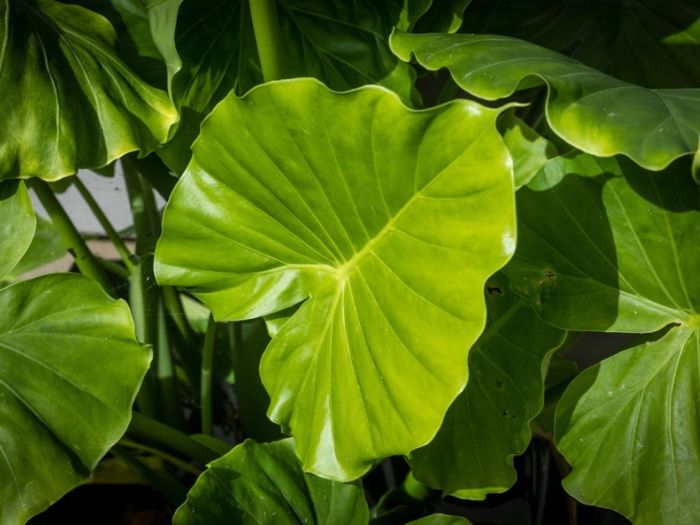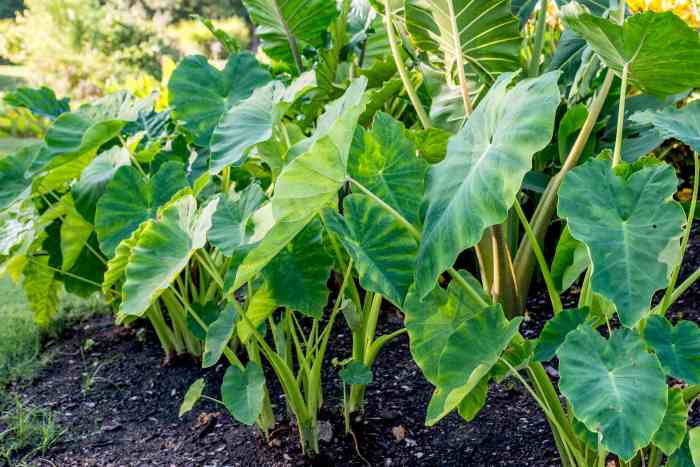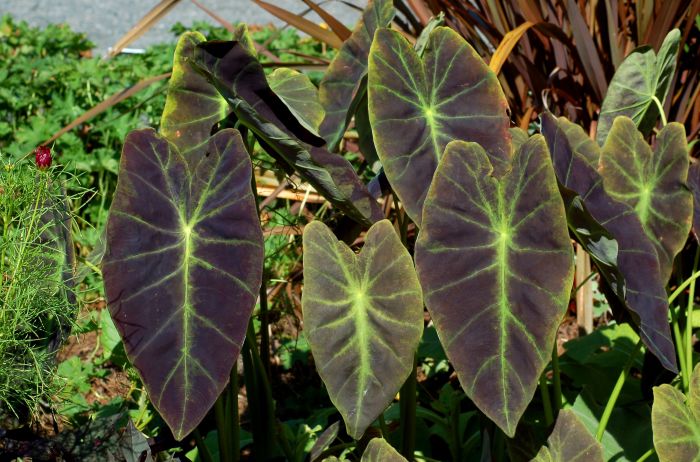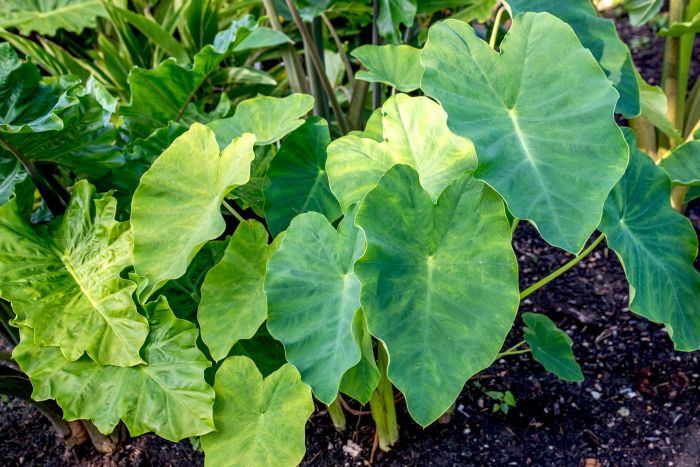Care of elephant ears – Elephant ears, renowned for their captivating foliage and architectural presence, demand specialized care to thrive and showcase their majestic beauty. This comprehensive guide unveils the secrets of nurturing these magnificent plants, empowering you to create a breathtaking garden oasis.
From understanding their environmental preferences to managing pests and diseases, we delve into every aspect of elephant ear care, providing practical tips and expert insights to guide you every step of the way.
Environmental Requirements for Elephant Ears

To thrive, elephant ears require specific environmental conditions. Understanding these requirements is crucial for successful cultivation and optimal growth.
Light Conditions:Elephant ears prefer bright, indirect light. Avoid placing them in direct sunlight, as this can scorch their leaves. In low-light conditions, they may become leggy and produce fewer leaves.
Temperature
Elephant ears flourish in warm temperatures. They thrive in a range of 65-85°F (18-29°C). When temperatures drop below 55°F (13°C), they may go dormant or even die.
Soil pH, Care of elephant ears
Elephant ears prefer slightly acidic to neutral soil, with a pH range of 6.0-7.0. Soil that is too acidic or alkaline can inhibit nutrient uptake and stunt growth.
Water and Nutrient Management for Elephant Ears
Proper watering and nutrient management are crucial for maintaining healthy and thriving elephant ear plants. Understanding the specific requirements of these plants ensures optimal growth and prevents potential issues.
Watering Techniques
Elephant ears prefer consistently moist soil but are susceptible to overwatering. Water deeply and infrequently, allowing the top few inches of soil to dry out before watering again. Avoid overhead watering, as this can promote leaf diseases. Instead, water directly at the base of the plant, ensuring the water reaches the roots effectively.
Fertilizer Requirements
Elephant ears are heavy feeders and require regular fertilization for vigorous growth. Use a balanced fertilizer with equal parts nitrogen, phosphorus, and potassium (e.g., 10-10-10). Fertilize monthly during the growing season, applying the fertilizer according to the manufacturer’s instructions.
Nutrient Management
Maintaining optimal nutrient levels in the soil is essential for healthy elephant ear growth. Regularly test the soil to determine its pH and nutrient content. Adjust the pH as needed, aiming for a slightly acidic range between 6.0 and 6.5. Amend the soil with organic matter, such as compost or manure, to improve drainage and provide additional nutrients.
Avoid over-fertilizing, as this can lead to nutrient burn and damage the plant.
Pest and Disease Control for Elephant Ears: Care Of Elephant Ears
Elephant ears, known for their majestic foliage, can be susceptible to pests and diseases that threaten their health and aesthetic appeal. Understanding common threats and implementing effective control measures is crucial for maintaining healthy elephant ears.
Common Pests and Control Measures
Aphids, spider mites, and mealybugs are common pests that feed on elephant ear sap, causing yellowing, stunted growth, and honeydew secretion. Aphids can be controlled with insecticidal soap or neem oil, while spider mites and mealybugs can be managed with horticultural oil or insecticidal soap.Slugs
and snails feed on elephant ear leaves, leaving ragged holes and slimy trails. Physical barriers such as copper tape or diatomaceous earth can deter these pests. Additionally, handpicking or using slug and snail bait can effectively reduce their populations.
Prevalent Diseases and Treatment Options
Fusarium wilt is a fungal disease that causes yellowing, wilting, and eventual plant death. Treatment involves removing infected plants and applying fungicides to prevent further spread.Bacterial leaf spot manifests as brown or black spots on leaves, leading to leaf loss.
Treatment includes removing affected leaves and applying copper-based fungicides.
Preventive Measures to Minimize Pest and Disease Issues
Maintaining good cultural practices can significantly reduce pest and disease problems. Proper watering, fertilization, and mulching promote healthy plant growth and resilience. Inspecting plants regularly for early signs of pests or diseases allows for timely intervention.Using pest-resistant elephant ear varieties, practicing crop rotation, and avoiding overcrowding can further minimize pest and disease susceptibility.
By implementing these preventive measures and employing effective control strategies, elephant ears can thrive and showcase their captivating foliage.
To ensure the well-being of elephant ears, proper care is crucial. For expert guidance on plant care, explore Discover the Enchanting World of Bunnings Plant Baskets: A Guide to Types Uses and Care , a comprehensive resource on all aspects of plant cultivation.
By understanding the specific needs of elephant ears, you can create a thriving environment that fosters their growth and vitality.
Propagation and Transplantation of Elephant Ears

Propagating and transplanting elephant ears is a straightforward process that can be successfully undertaken by both experienced gardeners and beginners. This guide will provide detailed instructions on how to propagate elephant ears through division and transplant them for optimal growth and establishment.
Elephant ears, with their large, velvety leaves, add a tropical touch to any home. Proper care includes providing ample light and moisture. While they prefer to be planted in the ground, they can also be grown in hanging plants , which can save space and create a unique display.
Ensure the hanging plant has adequate drainage and support to accommodate the elephant ear’s size and weight.
Propagation through Division
Division is the most common method of propagating elephant ears. It involves separating a portion of the rhizome, which is the underground stem of the plant, from the parent plant. The following steps Artikel the process:
- Choose a healthy, mature elephant ear plant.
- Dig around the base of the plant and carefully lift it out of the ground.
- Using a sharp knife or spade, divide the rhizome into several sections, each with at least one growth bud.
- Replant the divided sections in well-drained soil, ensuring that the growth buds are facing upwards.
- Water the newly planted divisions thoroughly.
Transplanting
Transplanting elephant ears involves moving them from one location to another. This can be done to improve their growing conditions, such as providing more sunlight or better drainage. The following tips will help ensure successful transplantation:
- Choose a planting site that receives at least six hours of sunlight per day.
- Dig a hole that is twice as wide as the root ball and just as deep.
- Place the elephant ear plant in the hole and backfill with soil, tamping down gently to remove any air pockets.
- Water the plant deeply and apply a layer of mulch around the base to retain moisture and suppress weeds.
Best Time for Propagation and Transplantation
The best time to propagate and transplant elephant ears is in the spring or fall when temperatures are moderate. Avoid transplanting during the hot summer months, as this can stress the plants and reduce their chances of survival.
Design and Aesthetics of Elephant Ears

Elephant ears, with their bold foliage and architectural presence, offer a striking addition to any garden. Numerous cultivars exist, each boasting unique characteristics that cater to diverse design aesthetics.
Cultivars and Characteristics
-
-*Colocasia esculenta ‘Black Magic’
Giant leaves with deep purple-black coloration, creating a dramatic focal point.
-*Colocasia esculenta ‘Thailand Giant’
Elephant ears, with their broad, tropical leaves, require special care to thrive. Bunnings Orchid Soil: The Ultimate Guide to Nurturing Your Orchids provides valuable insights into the specific soil needs of these plants, ensuring optimal growth and lush foliage. By incorporating the recommended soil amendments and following the guide’s expert advice, elephant ear enthusiasts can create the perfect environment for their beloved plants to flourish.
Enormous leaves up to 6 feet in diameter, showcasing vibrant green hues.
-*Colocasia esculenta ‘Pink China’
Delicate leaves with pink veins and margins, adding a touch of elegance to borders.
-*Alocasia macrorrhiza ‘Frydek’
Distinctive arrow-shaped leaves with wavy edges and metallic veins, providing a sculptural element.
Incorporating into Garden Designs
Elephant ears excel in both formal and informal garden settings. Their large leaves can serve as:
-
-*Accents
Plant in groups of three or five to create visual interest and draw attention to specific areas.
-*Borders
Use as a natural screen or hedge to define garden beds and pathways.
-*Focal Points
When caring for elephant ears, it’s crucial to provide ample moisture and well-draining soil. To elevate their aesthetic appeal, consider using Bunnings Outdoor Ceramic Pots . These pots offer a stylish and functional solution, promoting healthy root growth and enhancing the overall beauty of your elephant ears.
Place a specimen plant in a central location to make a bold statement and anchor the garden design.
Closure

By embracing the knowledge and techniques Artikeld in this guide, you can cultivate flourishing elephant ears that will add a touch of exotic elegance and visual drama to your garden. Whether you’re a seasoned gardener or a novice enthusiast, this comprehensive resource will empower you to unlock the full potential of these captivating plants.
User Queries
How often should I water my elephant ears?
Water elephant ears regularly, especially during hot, dry weather. Allow the top inch of soil to dry out between waterings.
What is the best fertilizer for elephant ears?
Use a balanced fertilizer with a ratio of 10-10-10 or 12-12-12. Fertilize elephant ears every 4-6 weeks during the growing season.
How do I control pests on elephant ears?
Common pests include aphids, spider mites, and mealybugs. Use insecticidal soap or neem oil to control pests.